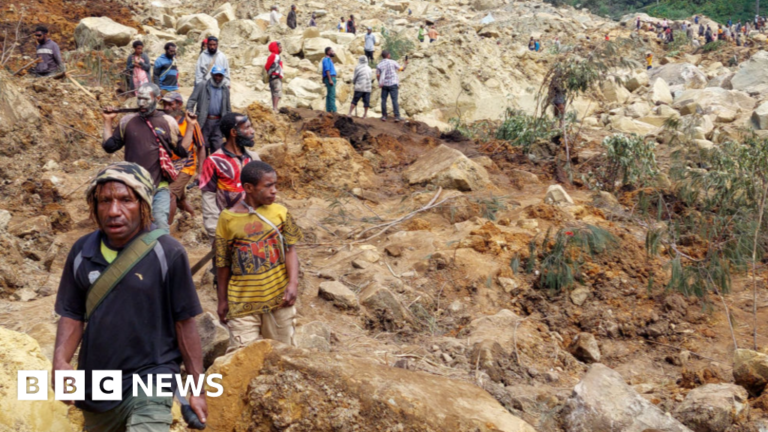The number of people missing following a deadly landslide in Papua New Guinea is feared to rise into the thousands, a government agency said.
The acting director of the National Disaster Center said in a letter that he feared more than 2,000 people may have been buried alive in Friday’s disaster.
However, it is difficult to establish an exact casualty figure and estimates vary widely, as rescue efforts have been hampered by rubble 10 meters deep in some places and a lack of adequate equipment.
Fewer than a dozen bodies have been found so far, while the United Nations (UN) puts the number missing at 670.
A mountainside collapse early Friday morning wiped out a bustling village in Enga province, with damage stretching nearly a kilometer, observers report.
Around 3,800 people lived in the area before the disaster.
Lusete Laso Mana’s letter says the damage is “significant” and has “had a major impact on the country’s economic lifeline.”
Prime Minister James Marape expressed his condolences and ordered the country’s defense forces and emergency agencies to the area, about 600 km northwest of the capital Port Moresby.
But residents of the affected village of Kaokalam say they are still waiting for authorities to intervene to launch larger relief operations.
A resident, Evit Kambu, said she believed many of her family members were trapped under the rubble and debris.
“I have eighteen family members buried under the debris and dirt I’m on. And I can’t count many other family members in the village,” she told the Reuters news agency.
“Thank you to everyone who came to help us. But I can’t collect the bodies, so I just stand here helpless.”
A community leader who visited the site told BBC residents they felt they had been left to their own devices. They used shovels and their bare hands to try to dig people out.
“It’s been almost three or four days now, but (many) bodies have not yet been located. The landslide continues to cover the area and people are really struggling to extract them. They are asking for support and assistance. government aid.” Ignas Nembo told the BBC’s Newshour programme.
However, a provincial police official told the BBC he saw soldiers arriving at the scene and trying to remove rocks to try to free those trapped.
Acting provincial police commander Martin Kelei called the efforts precarious, as the removal of car-sized boulders and other large barriers risked further damage. landslides.
“Digging is very difficult at the moment because we fear more landslides and more deaths. Local people are only digging where they can see that it is safe. We are trying to identify wherever we can see people buried,” he said. said.
He has visited the site several times since Friday’s collapse and said survivors could still be heard calling for help beneath the rubble.
Local media reported that a couple had been pulled alive from under the rocks. They had survived because their house was only on the edge of the landslide.
They were rescued after rescuers heard their cries for help, local broadcaster NBC reported.
Remaining residents are being evacuated as the area remains at high risk due to forecasts of further rain.
“The ground is also very unstable at the moment and is at risk of further landslides,” said Justine McMahon, national coordinator for Care Australia, one of the aid agencies on the ground.
“We have decided to stay outside for now to give the authorities time to fully assess the situation and carry out rescue and recovery operations.”
Earlier, an official from the UN migration agency in the country also described the difficulties involved in the rescue to the BBC.
Serhan Aktoprak of the International Organization for Migration said teams trying to recover the bodies faced a number of difficulties, including the reluctance of some grieving relatives to let heavy machinery near their relatives.
Instead, he explained, “people use digging sticks, spades and large agricultural forks to remove bodies buried beneath the ground.”
Debris from the landslide, including large rocks, trees and displaced earth.
Teams on site also say that rescue efforts are hampered by significant damage on the only road leading to the town. The landslide damaged a length of about 200 meters (650 feet), Ms McMahon said.
The Mount Mungalo landslide occurred in the Enga Highlands in the north of the island nation.
Local officials and journalists attributed the mountain’s collapse to weeks of heavy rains and other wet conditions in the area.
With reporting from Tiffanie Turnbull in Sydney


